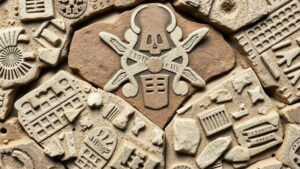Prompting AI to Compare Historical Economic Data with Likely Relic Sites
Prompting AI to Compare Historical Economic Data with Likely Relic Sites
As artificial intelligence (AI) technology advances, its application in the field of historical economic analysis and archeological research has begun to gain traction. This article explores how AI can be utilized to compare historical economic data with potential relic sites, enhancing our understanding of past civilizations and their economic practices. By analyzing historical records and economic indicators alongside geographic and archeological data, researchers can uncover patterns that may not be readily visible through traditional methods.
Understanding the Intersection of Economics and Archaeology
The intersection between economics and archaeology offers a fertile ground for inquiry. Historical economic data may include trade routes, currency usage, population densities, and resource distribution patterns, while relic sites often represent the physical remnants of ancient societies. Collectively, these elements enable researchers to reconstruct the economic landscapes of past cultures.
For example, consideration of the Roman Empires trade networks highlights how economic data can inform archaeological expectations. The Roman economy heavily relied on trade facilitated by established roads and maritime routes. By mapping these routes against known archaeological sites, researchers can prioritize excavation efforts and contextualize findings.
Utilizing AI in Data Comparison
AI technologies are particularly adept at processing vast amounts of data efficiently. Machine learning algorithms can be employed to analyze historical economic data and geographic information system (GIS) data to identify potential relic sites with high probabilities of containing significant artifacts. This process usually involves several steps.
- Data Collection: Historical economic data can be sourced from databases such as the Economic History Association and the World Bank. This might include GDP estimates, trade statistics, and demographic data.
- Data Preprocessing: The data must be cleaned and normalized to ensure compatibility with GIS datasets, which may include topographical maps and previously recorded excavation sites.
- Pattern Recognition: AI algorithms, particularly those employing neural networks, can be trained on this dataset to recognize patterns indicative of potential relic sites, incorporating factors such as proximity to water sources, trade routes, and agricultural viability.
Case Studies and Applications
One prominent case study involves the application of AI in the identification of relic sites in the ancient city of Teotihuacan, Mexico. Researchers utilized economic data, including population density and resource exploitation metrics, to direct their archaeological efforts. By correlating these indicators with remote sensing data, AI tools pinpointed areas of high potential for undiscovered structures.
According to a 2021 study published in the journal Nature, AI applied to remote sensing data can increase site identification accuracy by up to 40%. This efficacy was demonstrated through automated analysis of satellite imagery combined with known archaeological parameters.
Challenges and Limitations
While the use of AI in this context is promising, challenges do exist. Historical economic data can often be incomplete, biased, or misinterpreted, leading to erroneous insights. Plus, reliance on AI may inadvertently downplay the qualitative aspects of archaeology, such as cultural significance and human behavior, that are not easily quantified. To mitigate these issues, researchers must approach findings with caution and integrate interdisciplinary expertise.
- Data Quality: Poor quality or biased historical data can skew AI predictions.
- Interdisciplinary Approaches: Collaboration between economists, archaeologists, and AI specialists is essential to ensure a balanced interpretation of results.
Conclusion and Future Directions
As AI continues to evolve, its integration into historical economic analysis and archaeological site identification holds substantial potential for yielding unique insights into the socio-economic dynamics of past civilizations. Future research may involve developing more advanced algorithms that consider socio-political factors alongside economic data and exploring ways to improve data accuracy through enhanced collaboration across disciplines.
In summary, the application of AI to compare historical economic data with likely relic sites transforms how researchers engage with the past, promoting a more nuanced understanding of historical economies and their corresponding archaeological manifestations.



